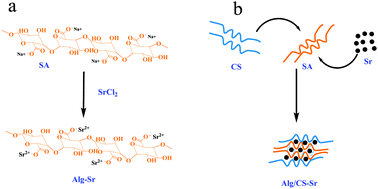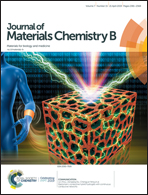In situ fabrication of a composite hydrogel with tunable mechanical properties for cartilage tissue engineering†
Abstract
A composite hydrogel with tunable mechanical properties has been fabricated and characterized in this study. We investigated its swelling degree, morphology, structure and thermal stability. Moreover, the effect of strontium chloride concentration on both the dynamic rheology and nanomechanical properties of the composite hydrogels was confirmed in this work. To eliminate the viscoelastic influences of hydrogels during nanomechanical tests, we first analyzed the elastic modulus of strontium alginate (Alg-Sr) and strontium alginate/chondroitin sulfate (Alg/CS-Sr) hydrogels via atomic force microscopy (AFM) using the rate-jump method. Chondrocytes were cultured with the Alg-Sr and Alg/CS-Sr hydrogels respectively. Cell viability assay reveals that the Alg/CS-Sr hydrogel possesses good cytocompatibility. Flow cytometry, qPCR and western blotting analysis suggest that the Alg/CS-Sr hydrogel exerts a positive effect on the inhibition of apoptosis and may exert anti-inflammatory effects in articular cartilage related applications. Furthermore, the preliminary in vivo study shows that the Alg/CS-Sr composite hydrogel facilitates the repair of cartilage in rabbit cartilage defect. Taken together, it is indicated that the Alg/CS-Sr composite hydrogel might be a promising scaffold to promote the repair of cartilage defects.



 Please wait while we load your content...
Please wait while we load your content...